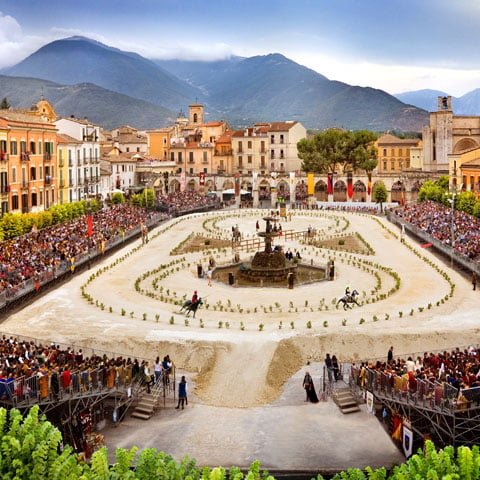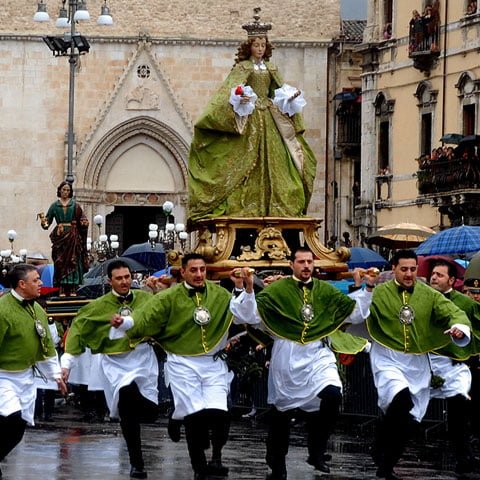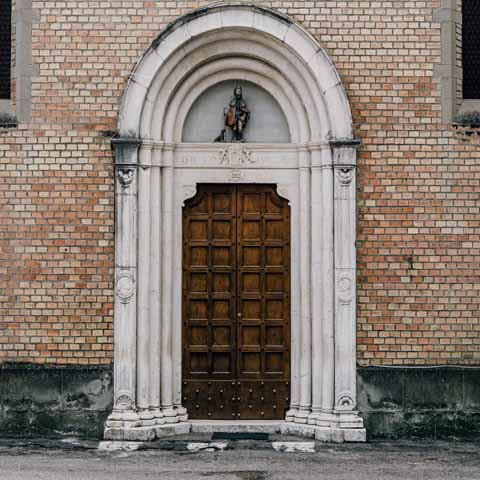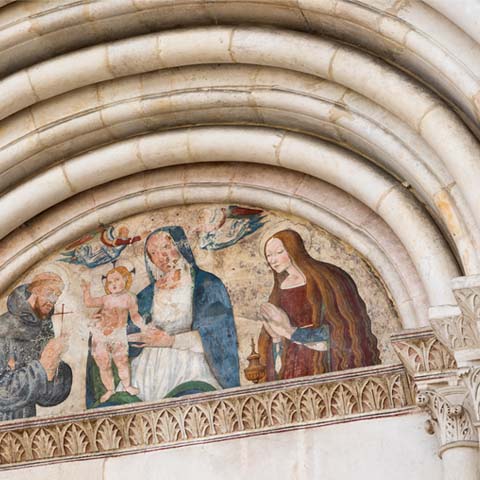Located in the Sulmona basin at the confluence of the Vella and Gizio Rivers, Sulmona is one of the most important cities in Abruzzo. Its territory is included in the National Park of Majella, a region of rare beauty. In fact, Sulmona is one of the main attractions of the region, famous for the production of confetti and many other artisanal products.
Its proximity to the Rome-L’Aquila-Pescara motorway encouraged industrial development, as well as spurring growth in the agricultural sector, including the cultivation of cereals, wine grapes, fruit, and vegetables. But Sulmona is also renowned for its flourishing artisanal sectors and the arts of inlay, wrought iron, and embossed copper.
The city preserved its medieval charm, and many testimonies from the Middle Ages can be seen in the old town. For example, the Cathedral of San Panfilo, which was erected on a Roman temple of Apollo and Vesta, was rebuilt and given a Romanesque façade between 1078 and 1119.
Restored several times, the edifice still preserves its original charm and fascinates locals and tourists alike. The crypt with three naves and three apses shows an eighteenth-century façade but preserves a Gothic portal, while the interior of the basilica is decorated with Baroque elements. This blend of styles shows the development of a rich culture throughout the centuries.
But the most complex monument in Sulmona is the Palace and Church of the Annunciation, founded in 1320 and located in Piazza dell’Annunziata. The edifices were built during a few centuries and hold evidence of the cultural evolution of the settlement.
The palace is remarkable, with portals and Gothic details that are truly spectacular. Currently, the palace houses a Civic Museum, which is extremely important from an archaeological point of view. Some of the most important artifacts are artworks of local goldsmiths from the fourteenth and fifteenth centuries, an artform that is still flourishing in the city.
Other monuments with a historical importance are the Church of San Francesco della Scarpa, erected in 1290 and rebuilt in the eighteenth century, the Church of Santa Maria della Tomba from 1241 which was remodeled during the Renaissance, the monumental Naples Gate from the sixteenth century, and an aqueduct with ogival arches.
PREHISTORY OF SULMONA
Sulmona has been inhabited since the earliest times, and the city is mentioned in the ancient chronicles of Ovid and Silio Italico. Both personalities agree on the prehistoric origin of Sulmona, which is linked to the destruction of Troy. The name of the city derives from Solimo, one of the companions of Aeneas.
However, the first attestable historical testimony comes from the Roman emperor Titus Livius who mentions Sulmona in some findings individuated in an oppidum. The evidence shows how the city remained loyal to Rome despite the lost battles of Trasimeno and Canne.
But evidence found in the surrounding territories attests to human presence much earlier than the Roman age. Like many other territories in the region, it is believed that Sulmona’s territory was first inhabited by the Sabines, an indigenous civilization that played an important role in the formation of Rome.
The oppidum that documents how Sulmona turned its back on Hannibal has left some archaeological traces, especially in the area of Mount Mitra, indicating Sulmona as one of the largest fortified settlements in Central Italy.
The area located above the current site of the city holds important archaeological evidence from the prehistoric and historic times.
HISTORY OF SULMONA
The peoples inhabiting the fortified settlement of Sulmona settled themselves between the Gizio and Vella Rivers in the Roman period. Situated in Peligna valley, Sulmona now stands on a territory originally occupied by a vast lake. Disastrous earthquakes shook the whole region and caused the rock barrier that blocked the passage of the water towards the sea to collapse, leaving behind a muddy yet fertile soil that encouraged the formation of new settlements.
As a result, Sulmona became one of the three most important municipalities in the region in the Roman era, together with Corfinium and Superaequum.
In 81 BC, the city suffered serious damage after being involved in struggles against Sulla. Rebellions followed the events in an effort to obtain autonomy, and the period of decay continued for more than thirty years. However, under the rule of Caesar, the city was resurrected thanks to the establishment of a Pompeian garrison who put an end to the revolts.
An important event in the history of Sulmona was the birth of the illustrious poet Publius Ovidius Naso, known as Ovid, in 43 BC. Exiled to Tomis, today’s Costanza located in Romania, the poet wrote “Sulmo Mihi Patria Est,” a phrase from which the city borrowed the initials written on its coat of arms, “S.M.P.E.”
Christianity arrived in Sulmona in the third century AD, and this is documented by a funerary inscription dedicated to the neophyte Peticius Habentius. Initially, only one diocese was established in the area, the Diocese of Valva. But due to some controversies between the various settlements, the Diocese of Sulmona was also soon established.
However, the Diocese of Sulmona was only assigned a bishop in the fifth century, when Palladio participated in the first Roman synod organized by Pope Symmachus.
During the Middle Ages, the most fruitful period for the city was the one of the Swabians who acted in support of Sulmona and forced the bishop to place his seat inside the city walls. During the reign of Frederick II, the city witnessed a period of intense development, including exceptional civil works, such as the Medieval Aqueduct, which is one of the most important monuments of the period.
From a political point of view in this period, Sulmona became a municipality together with Marsica in a province controlled by the Normans. With the statutes of Melfi, Frederick II granted Sulmona the rank of capital and seat of the Curia in a province formed by the territories of Peligna, Marsica, and the Diocese of Forcona, which would become the future L’Aquila. This new land received the name of Abruzzo, derived from the common denomination of the territories, Aprutium. Peculiarly, this is the only region established by Frederick II that did not undergo major territorial changes over the centuries.
As capital and seat of the Curia, Sulmona started to develop on all levels, becoming the seat of Giustizierato d’Abruzzo under the Kingdom of Sicily. But this golden age was not destined to last, and in the thirteenth century the situation changed with the crowning of Pope Celestine V in L’Aquila.
Despite the new rising municipality which started to threaten the position of Sulmona within the region, the city still maintained many of its privileges. One of the most important powers in the city was the monastic congregation of the hermits of San Damiano, while Pope Celestine V tried to retire to Sulmona after abdicating from his duties in favor of Pope Boniface VIII.
With the fall of the Swabians and the advent of the Anjou, Sulmona entered a period of decay as a result of the municipality’s loyalty towards Frederick II. The Anjou deprived Sulmona of Giustizierato and closed the Faculty of Canon Law that was flourishing in the city.
But the Renaissance brought a new period of remarkable splendor. In the fourteenth century, the city tripled its surface and received a second circle of city walls with six imposing gates. From a cultural point of view, Sulmona had a remarkable contribution to the Renaissance through personalities such as Barbato da Sulmona and Giovanni Quatrario. The Palazzo dell’Annunziata was built during this period, which is an edifice that served as an asylum for orphans and a hospital.
During the sixteenth century, the famous Scuola Orafa Sulmonese was born, which is where goldsmiths were taught the craft. Moreover, industrial development also reached the city, including a paper industry and various factories along the Gizio River.
Trade in the area also had remarkable growth thanks to the development of silk and other precious fabric factories. Towards the end of the century, the art of printing was introduced, allowing the municipality to publish the works of Ovid.
However, this intense growth of the city had stopped in the seventeenth century. This period is identified with a poor social life in which the only example of vitality was the participation of the city in the revolutionary movement of Masaniello. But after a short period of time, the nobles won the struggles and the leaders of the revolt were executed.
Giostra Cavalleresca is an event that was first held in 1656, organized twice a year to entertain the inhabitants. But the terrible plague that followed caused the municipality to cease the festivities that were only reassumed in 1995.
During the same century, many of the churches in the city underwent important restoration changes and received Italian style organs.
In 1706, the disastrous earthquake that hit the whole region took its toll on the city. Sulmona was razed to the ground, but the unfortunate event awakened the citizenship who started to rebuild the settlement.
The nineteenth century marked a new period of rebirth. Thanks to the city’s strategic position, Sulmona was included in the new infrastructure plans, including the passage of the railway through the city. This marked the beginning of a new period of considerable development, characterized by a strong economic growth and demographic expansion.
The twentieth century was characterized by alternating periods, including the construction of the City Theatre in 1950, the reconstruction of historic buildings and the return to forgotten traditions. One of the events that marked the history of the city in the first part of the century was the passage of the Tour of Italy through Sulmona for the first time, in 1911.
World War II had a strong impact on the city. Sulmona suffered serious damage resulting in a massive depopulation of the whole area. The city was bombed with particular violence, as it constituted an important railway node. But despite all adversities, the first signs of restoration were seen in November 1946, soon after the end of the war.
Although completely destroyed, the area of the city was totally rebuilt and the State Archives present in the municipality were reconstructed. After some periods of rebellion against the institutions, in an attempt to become the capital of the province, Sulmona entered in a period of apparent tranquility, characterized by a slow yet steady growth.
Today, Sulmona is a vibrant city recognized for its historic architecture, natural scenery, and confetti tradition.
ARCHAEOLOGY IN SULMONA
Archaeology, especially artifacts from the Roman times, are well represented in Sulmona. Traces of the Roman settlement were recently excavated and include the remains belonging to a Temple of Hercules, which some archaeologists believe to be the ruins of the Villa of Ovid.
An important artifact from the region is a bronze statue of Hercules, which is currently exhibited in the Archaeological Museum of Chieti. This small bronze statue, probably the gift of a merchant, dates back to the third century BC and depicts the ancient hero leaning on his left arm on a club from which hangs a lion’s skin. Due to the abundance of details, this artifact is considered one of the masterpieces of the time.
Besides the statue, many architectural and votive materials were found at the same temple, located at the foot of Mount Morrone.
A noteworthy artifact is a column holding two elegant verses signed by Ovid. Supposedly written on marble by Ovid himself, they are considered evidence of the poet’s origins.
Apart from this, the city’s museums hold and exhibit numerous permanent collections of artifacts found scattered throughout the territory, including prehistoric evidence that confirms the passage of various cultures and civilizations.
Don't just see Italy, live it.
Your dream trip to Italy has never been closer
No more endlessly scrolling travel sites. Our travel experts will craft the perfect, one-of-a-kind trip just for you.

300+
DESTINATIONS
We offer more Italian destinations than any travel site. Do and see more with Trips 2 Italy.
1 (of a kind)
ITINERARIES
Because your dream trip to Italy should be designed for you, not for the masses.
100%
PEACE OF MIND
From flights and accommodations, to food and activities - we take care of every detail.







